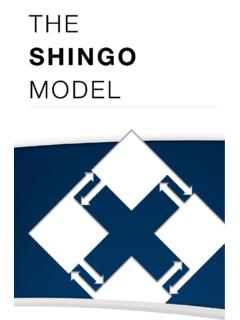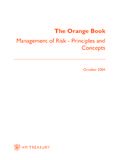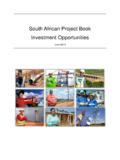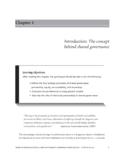Transcription of Executive Summary rev1 - flowcastingbook.com
1 FFlloowwccaassttiinngg tthhee RReettaaiill SSuuppppllyy CChhaaiinn EExxeeccuuttiivvee SSuummmmaarryy BByy AAnnddrr MMaarrttiinn,, MMiikkee DDoohheerrttyy aanndd JJeeffff HHaarrrroopp Page 1 TThhee SSuummmmaarryy iinn BBrriieeff The retail store has been disconnected from planning the supply chain, even though the majority of planning problems can only be addressed at store level. For example, retail out-of-stocks are a major problem for retailers and their trading partners, yet no substantial progress has been made on this front in the last 20 years. Planning the retail supply chain must start at store level. By starting at the store and producing forecasts of consumer demand, all other demands in the supply chain can be calculated. The result is order-of-magnitude improvements in reducing out of stocks and improving inventory performance and profitability for all members of the extended retail supply chain.
2 Retailers and their trading partners can increase profitability by 1-6% of top line sales by using Flowcasting to plan the retail supply chain! WWhhaatt YYoouu llll LLeeaarrnn iinn tthhiiss EExxeeccuuttiivvee SSuummmmaarryy A forecast of store-level consumer demand is the only forecast that any retail supply chain needs. This forecast is easily translated into demand, supply and inventory projections for all other partners in the supply chain. There will be no need for suppliers to forecast their upstream customers demands. A number of supply chain planning problems are resolved, or significantly improved, using Flowcasting. These include: virtually eliminating retail out-of-stocks (even during promotions), minimizing seasonal inventory carryover and flawlessly executing on assortment, operational and financial planning. Flowcasting provides a single set of numbers, or a single version of the truth, to which all supply chain partners can plan.
3 Flowcasting translates consumer demand forecasts into demand projections, manpower and equipment requirements, capacity requirements and financial plans for all trading partners. Flowcasting allows people to work by exception and see the future. People can identify problems before they occur and take action to resolve them before they happen. Flowcasting ensures that retailers and their trading partners are ultra-competitive. Results to date have proven that using Flowcasting retailers and their trading partners can improve bottom line performance by 1-6%. The success of Flowcasting is dependent on people and process. People make the Flowcasting process work. The more sustained effort you invest in education, training, process design and integration, the better will be your results. FFlloowwccaassttiinngg tthhee RReettaaiill SSuuppppllyy CChhaaiinn EExxeeccuuttiivvee SSuummmmaarryy BByy AAnnddrr MMaarrttiinn,, MMiikkee DDoohheerrttyy aanndd JJeeffff HHaarrrroopp Page 2 SSeeccttiioonn 11:: TThhee NNeeeedd ffoorr FFlloowwccaassttiinngg Starting at Store Level The retail store is often considered the weakest link in the retail supply chain a notion supported by numerous surveys conducted over the past 10 to 15 years regarding out-of-stocks.
4 Retail store out-of-stocks (usually in the 5 percent to 8 percent range) are indeed much worse than the percentage of out-of-stocks that occur elsewhere across retail supply chains. Even worse, those numbers balloon to almost 15% during promotions. The nodes in a retail supply chain are highly interdependent. And when they re managed as such, the benefits that accrue to the trading partner are staggering in terms of reducing costs and improving customer service two keys in winning today s retail race. Forecasting Today Every Node for Itself Today s forecasting happens everywhere, but where it really counts at store level. Consider the following chart, which outlines the many functions and types of forecasts that retailers do today: New equipmentInventoriesNew productsManpowerShippingStore closingsCustomer serviceReceivingNew storesShippingSpace plansNew productsEarnings per shareCash flowReceivingInventoriesPromotionsCapita l expendituresProfitsWarehousingManpowerSa les plansProfitsRevenuesTransportationSalesM arketing plansRevenuesFinanceDistributionStoresSa les and MarketingTop ManagementNew equipmentInventoriesNew productsManpowerShippingStore closingsCustomer serviceReceivingNew storesShippingSpace plansNew productsEarnings per shareCash flowReceivingInventoriesPromotionsCapita l expendituresProfitsWarehousingManpowerSa les plansProfitsRevenuesTransportationSalesM arketing plansRevenuesFinanceDistributionStoresSa les and MarketingTop ManagementWho is ForecastingWhat They re Forecasting Figure 1: Retailer s functional forecasting activities.
5 Clearly, retailers spend a significant amount of time and effort on forecasting activities. The same is true for manufacturers and wholesalers. Since the retail supply chain is not linked, it s every node for itself everyone is forecasting. FFlloowwccaassttiinngg tthhee RReettaaiill SSuuppppllyy CChhaaiinn EExxeeccuuttiivvee SSuummmmaarryy BByy AAnnddrr MMaarrttiinn,, MMiikkee DDoohheerrttyy aanndd JJeeffff HHaarrrroopp Page 3 The result of this forecast-everywhere-but-where-it-counts approach is that forecast performance has actually worsened over time: o Low forecast accuracy was one of the key findings in a recent Grocery Manufacturers of America study by Roland Berger Strategy Consultants. Errors at the national, monthly item-level - measured as mean absolute percentage error (MAPE) - were 23 percent in 1996 and 31 percent in 1999. In 2002, the error rate had increased - to 34 percent on a national, monthly level and 44 percent on a shipping location level.
6 O How can this be? Major investments in new forecasting practices and technology over a sustained time period, and it s getting worse. Dependent Demand Years ago in the auto industry, people realized that once you forecasted how many of a particular car model you would assemble and then sell, you could easily calculate the demand for tires, steering wheels, hubcaps and a variety of other parts. These component level forecasts were based on dependent demand that is, they depended entirely on the demand for finished cars. The concept of dependent demand is important in retail planning as well. Consider the supply chain shown in Figure 2. At every node of this distribution channel, a customer/supplier relationship has been created. For example, the factory has one customer, MDC1. MDC1 plays a dual role it is the customer of the factory and the supplier to RDC1 and RDC2.
7 RDCs 1 and 2 also play dual roles; each is a customer of MDC1 and each is a supplier to a specific number of stores (two each in this example). Store 108 Store 108 Store 602 Store 602 Store 760 Store 760 Store 770 Store 770 RDC1 RDC1 RDC2 RDC2 MDC1 MDC1 FactoryFactory Figure 2: Dependent demand in a retail supply chain. FFlloowwccaassttiinngg tthhee RReettaaiill SSuuppppllyy CChhaaiinn EExxeeccuuttiivvee SSuummmmaarryy BByy AAnnddrr MMaarrttiinn,, MMiikkee DDoohheerrttyy aanndd JJeeffff HHaarrrroopp Page 4 When store 108 needs products, it orders from RDC1. When RDC1 needs products it will order from MDC1. The product demand that RDC1 experiences will always be generated by stores 108 and 602. In other words the demand on RDC1 is dependent on the needs of stores 108 and 602. Another way to look at this distribution channel is to think of the way products will normally flow from factories to store shelves. Once you have forecasted what consumers will buy at the store level, you can calculate the demand flow through every node and trading partner within this distribution network.
8 And this makes perfect sense. After all, we build distribution centers to serve the demands of other DCs and stores. So why not have forecasting and planning processes and systems follow in the same path that support the way we actually do business? The Power of One (Forecast) Manufacturing Resource Planning (MRPII) has been used in manufacturing to manage inventories for decades. Distribution Resource Planning (DRP) applied the same principles to the management of distribution inventories, resulting in significant improvements in fill rate and inventory turns. Flowcasting extends this thinking to the retail store the place where the information flow starts and product flow ends thereby closing the supply chain loop with a common process for all nodes. The solution is simple and intuitive first, create a model of total supply chain from the factory to the store shelf inside the same system (see the picture below), then make a forecast for what consumers are going to buy, item by item and store by store.
9 With a clear picture of demand at the ultimate point of sale, schedule all upstream supply nodes to meet demand. The calculated supply schedules are just basic math using DRP logic at every location, including each store. As shown in Figure 3, forecasting only needs to happen at the final point of sale, the retail store. The calculated demand at each level, from retail stores through the supplier s factories, is the one set of numbers that can be converted into meaningful units within each functional area of the supply chain. RetailStoreRetailDCManufacturerDCManufac turerPlantRaw MaterialSupplierForecastForecastCalculat e Figure 3: One sales forecast only at store level. FFlloowwccaassttiinngg tthhee RReettaaiill SSuuppppllyy CChhaaiinn EExxeeccuuttiivvee SSuummmmaarryy BByy AAnnddrr MMaarrttiinn,, MMiikkee DDoohheerrttyy aanndd JJeeffff HHaarrrroopp Page 5 Why is this Better? Forecasting at store level and calculating dependent demand throughout the extended retail supply chain is far superior to today s approaches since: o Everyone is focused on consumer demand and can collaborate on developing the best possible forecast of consumer demand o It can eliminate all forecasting happening today at the DC level, Wholesale level and at the Manufacturing level o Forecasting at the distribution center level actually introduces a significant source of error: store-level inventory levels.
10 If the stores have too much inventory, any RDC level statistical forecast based either on aggregate sales history or warehouse withdrawals will yield forecasts that are larger than what is actually needed. The result is even more excess inventory. If the stores don't have enough inventories, any RDC level statistical forecast based on the aggregate sales history or warehouse withdrawals will generate a forecast that is too low, resulting in out-of-stocks. o It factors in store-level inventories precisely where they count: at the store level plan. These include store on-hand balance, shelf resets, delivery schedules, minimum shipping quantities, supplier ordering rule changes, product phase in/phase out, and so on. Consider Figure 4 which shows the sum of the POS forecast for a product at a number of stores supported by a retail DC, as well as the projected demand (dependant demand calculation) on the distribution center from the same stores.






